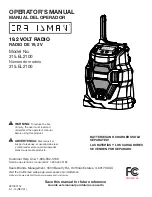
Switches
Device Settings
1
2
3
4
5
6
7
8
Parity: None
OFF*
OFF*
Parity: Even
OFF
ON
Parity: Odd
ON
OFF
Disable serial (low power mode) and enable the
receiver slots select for switches 1-2
ON
ON
900 MHz: 1.00 Watt (30 dBm) transmit power **
2.4 GHz models: 40 ms frame
OFF*
900 MHz: 0.25 Watts (24 dBm) transmit power **
2.4 GHz models: 20 ms frame
ON
Application mode: Modbus
OFF*
Application mode: Transparent
ON
MultiHop radio setting: Repeater
OFF*
OFF*
MultiHop radio setting: Master
OFF
ON
MultiHop radio setting: Slave
ON
OFF
MultiHop radio setting: Reserved
ON
ON
* Default configuration
** For 2.4 GHz radios, the transmit power is fixed at 0.065 Watts (18 dBm). DIP switch 5 is used instead to set the frame timing.
Application Mode
The MultiHop radio operates in either Modbus mode or transparent mode. Use the internal DIP switches to select the mode of operation.
All MultiHop radios within a wireless network must be in the same mode.
Modbus mode uses the Modbus protocol for routing packets. In Modbus mode, a routing table is stored in each parent device to optimize
the radio traffic. This allows for point to point communication in a multiple data radio network and acknowledgement/retry of radio pack-
ets. To access a radio's I/O, the radios must be running in Modbus mode.
In transparent application mode, all incoming packets are stored, then broadcast to all connected data radios. The data communication
is packet based and not specific to any protocol. The application layer is responsible for data integrity. For one to one data radios it is
possible to enable broadcast acknowledgement of the data packets to provide better throughput. In transparent mode, there is no access
to the radio's I/O.
Baud Rate and Parity
Use the DIP switches to select the baud rate and the parity. The options for baud rate are: 19200, 38400, or 9600. For parity, select
None, Even, or Odd.
Disable Serial
If the local serial connection is not needed, disable it to reduce the power consumption of a data radio powered from the solar assembly
or from batteries. All radio communications remain operational.
Receiver Slots
The number of receiver slots indicates the number of times out of 128 slots/frames the radio can transmit to its parent radio. Setting a
slave’s receiver slots to 4 reduces the total power consumption by establishing that the slave can only transmit to its parent four times per
128 slots.
Transmit Power Levels/Frame Size
The 900 MHz data radios can be operated at 1 watt (30 dBm) or 0.250 watt (24 dBm). For most models, the default transmit power is 1
watt.
For 2.4 GHz radios, the transmit power is fixed at 0.065 watt (18 dBm) and DIP switch 5 is used to set the frame timing. The default
position (OFF) sets the frame timing to 40 milliseconds. To increase throughput, set the frame timing to 20 milliseconds. Note that in-
creasing the throughput decreases the battery life.
SureCross MultiHop Data Radio
4
www.bannerengineering.com - tel: 763-544-3164
P/N 148345 Rev. B


























